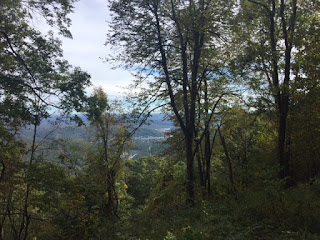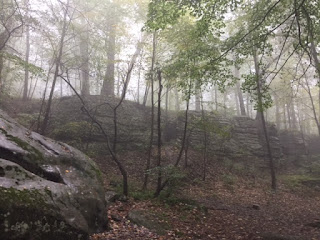One beautiful thing about living in Pittsburgh is that you can board a train here at 7:30am and arrive in New York City's Penn Station before 5:00pm. There's no changing trains and no long stops in between, nothing but the Appalachian Mountains, and Amish Country, and all the gritty, fascinating old towns between here and there. Yes, it's a nine-hour train ride...but the view from the windows is spectacular, especially if you go in October.
Pictured here is the famous Horseshoe Curve near Altoona, a marvel of mid-eighteenth century engineering that is loved by railroad buffs all the world over. I'm not exactly a railroad buff, but I sure did enjoy the long ride into Manhattan. Passing through these low mountains in their fading autumn glory, the train would blow its mournful whistle every now and again, and the scene could not have been more perfect.
We did a really quick family trip into New York to take the kids to a Broadway show: two days aboard the train and one whole day in the City. There were stops in Greensburg, Latrobe, Johnstown, Altoona, Huntingdon, Harrisburg, Elizabethtown, Lancaster, Paoli, Philadelphia, Trenton, and Newark. I failed to film the most beautiful stretches of the ride, like where the train runs along the Susquehanna River near Duncanon or through the quaint farmlands of Lancaster County, with their huge stone barns adorned with carefully painted hexes. I'm not a great fan of Broadway, and New York is an old familiar enemy, but the train ride was so worth the hassle.
Of course, no town looks good from the tracks. Railroads run through the seediest parts of any community, rural or urban. Or maybe it's just that railroads are industrial and move mainly through industrial or post-industrial zones. There's always so much decay and debris visible from a train. Still, it was a joy to see Philadelphia through the streaked windows of the Amtrak train. Looks like Philly's got yet another new skyscraper going up, too.



























